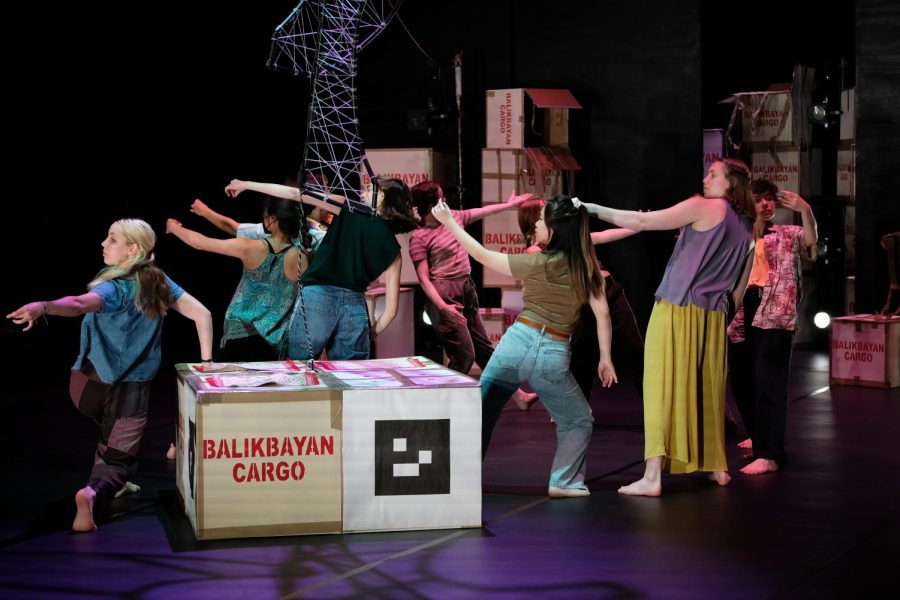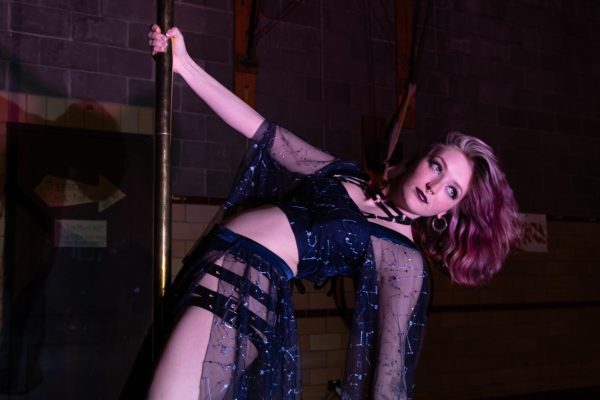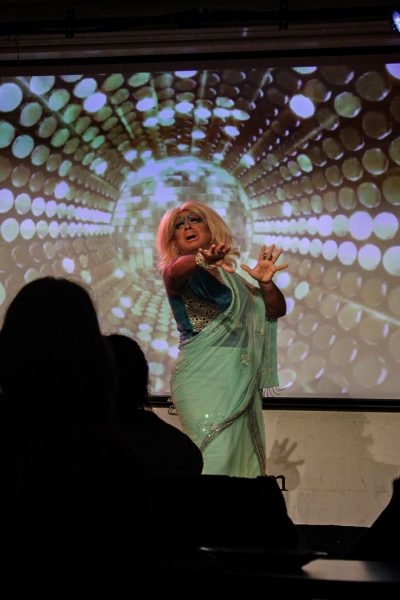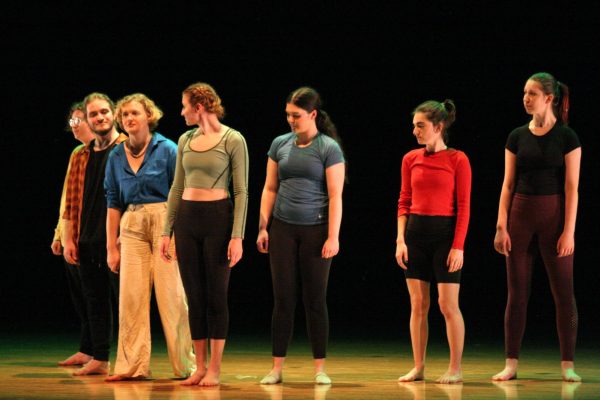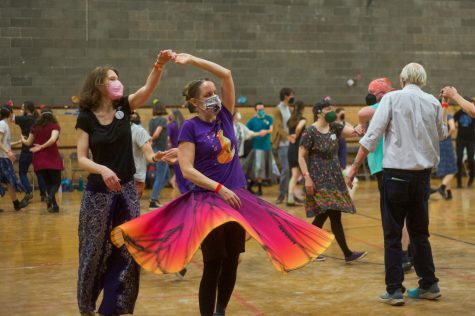Oberlin Dance Company Performs Somewhere Good
On May 20 and 21, Oberlin’s Dance, Theater, and TIMARA departments will collaborate on Somewhere Good with English for Speakers of Other Languages students of the Conservatory and residents of Kendal at Oberlin.
Bright, colorful artworks were on display in the lobby windows of the Irene and Alan Wurtzel Theater this past week, marking the first part of Assistant Professor of Dance Al Evangelista’s multidisciplinary project Somewhere Good. The project is a collaboration between Oberlin’s Dance, Theater, and TIMARA departments as well as a community project between Oberlin dancers, English for Speakers of Other Languages, students of the Conservatory, and residents of Kendal at Oberlin. This Friday and Saturday, the Wurtzel Theater will host students and community members to view the artwork up close and watch Oberlin Dance Company’s performance of Somewhere Good.
At its core, Somewhere Good is about double meanings: the queerness of gestures, the presence of absence, and the reality of loss — of family members that have passed, of histories that have been forgotten, and of voices that have been silenced.
The project will take place as a set of three exhibitions. The first is a display of art composed of ArtiFACTs made by Oberlin students and Kendal residents.
“The exhibits are an experiment in the many places we call home, how we remember them, and how we move in them,” Evangelista wrote in his director’s note, which ties into the second exhibit.
As the display moves from the lobby into the theater, one can see dozens of boxes labeled Balikbayan Cargo.
“These boxes, balikbayan boxes, are care packages typically sent by Filipino/a/x families in the United States to families still in the Philippines,” Evangelista wrote. “It continues a long tradition of sending remittances back to the Philippines.”
In this way, the stage invokes emotions associated with being away from home and family. The boxes signify the complexity of transpacific relationships, geographical separation, and familial love, thereby centering Filipinx and Filipinx-American history and culture.
“The last exhibit tonight is a historical one,” Evangelista wrote. “An exhibit that is invisible but heard and deeply felt. In 1904, the St. Louis World [Fair’s] main attraction was the ‘human exhibits.’ The largest ‘human zoo’ displays at St. Louis were the 70,000 Philippine exhibits hosting more than 1,200 ‘natives.’”
Evangelista emphasized that while the performance draws attention to forgotten and overshadowed histories like the 1904 “human zoos,” it also acknowledges people, voices, and stories that cannot be recovered.
“The movement tonight communicates the words lost, the words in bodies, and especially the words in motion,” he wrote. “This is not to say this is a project of recovery [or] absolution. Instead, this dance invites the integration of loss, tradition, and community.”
In preparation for the show, Evangelista asked ODC students to reflect on what this performance meant to them. College second-year and Dance major Aimee Watts described her experience as a dancer in the piece.
“I think this performance is about what it means to explore the ambiguity within the past and present of Filipino history and what it means to create a space for this history through all its loss and fragmentation,” Watts said. “When reaching toward an unknown past, it’s important to acknowledge that we do not know all these histories and lie witness to its loss and disjointedness.”
The disjointedness of loss can be seen when dancers interact with buttons atop the balikbayan boxes in the center of the stage. Pressing different buttons in different ways prompts the audio to start, change, stutter, and stop, which in turn, causes dancers to start, change, stutter, and stop as well. Watts remarked on what it feels like to be a part of this fragmentation.
“[We are] having to enact history as we have to physically press the button on stage,” she said. “As performers, in order to create these new relations between the unknown, known, past, and current, we use this ambiguity within space, time, history, and memory as an invitation.”
Loss, ambiguity, and fragmentation can, of course, be frustrating, and Somewhere Good highlights this frustration. College third-year and Dance and Creative Writing major Emmacate Sauer, another dancer in the show, noted how the technology involved in the performance makes it both challenging and unique.
“I feel like what excites me about it is I’ve done pieces with clear-ish narratives before, but I think I’ve never been a part of something that’s been as heavily researched,” Sauer said. “Also, the technology! That’s crazy and I’m still struggling with it.”
Sauer also linked the effect of the performance to the meaning behind it.
“Having the process and the dissemination of information near the goals of the work is something I’ve never thought about before,” Sauer said. “I did find it frustrating at times, but it’s kind of crazy and meta to think about. You don’t know this piece of information, because the idea is that you’re searching for the histories that have been obscured. As a dancer, you’re supposed to be kind of frustrated, and that’s a part of it.”
Somewhere Good has invited its participants to engage with Filipinx history and the difficulties of loss in diverse, creative, and beautiful ways. Evangelista, his creative team, and ODC extend this invitation to their audience.


